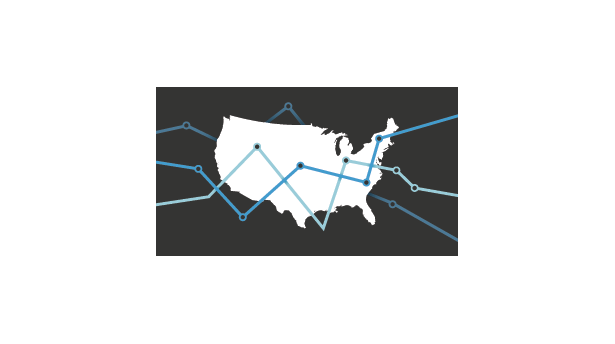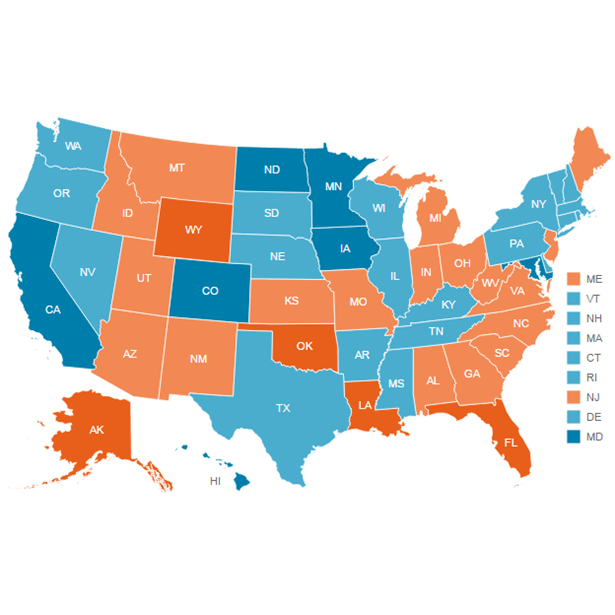Employment Rates Still Below Prerecession Levels in Most States
These data have been updated. To see the most
recent data and analysis, visit Fiscal 50.
Employment rates for 25- to 54-year-olds were lower in 28 states in 2014 than in 2007, before the Great Recession. This decline means less potential revenue for state governments from personal and business income taxes and sales tax—and often increased strain on assistance programs.
Leading up to the Great Recession in 2007, 79.9 percent of people ages 25 to 54 in the United States had a job. In 2014, more than five years after the recession ended, only 76.7 percent of people in that age group were working.
The difference between the rates in 2007 and 2014—a decrease of 3.2 percentage points in the employment-to-population ratio for adults in their prime working years—shows that the U.S. labor market remains weak.
Still, some improvement has occurred. In 2012, the employment rate for prime-age adults nationally was 4.2 percentage points below the prerecession level, and in 2013, it was 4.0 points below. Rates were down by statistically significant amounts in 37 states in 2012 and 34 states in 2013, compared with 28 states today.
A lower employment rate can have significant budgetary consequences for states:
- Without paychecks, people pay less income tax and tend to buy less, reducing sales and business income tax revenue.
- Unemployed people frequently need more services, such as Medicaid and other safety-net programs, increasing costs at a time when state governments may have less tax revenue.
A state-by-state comparison of the employment-to-population ratio for 25- to 54-year-olds in 2007 and 2014 shows:
- No state reported a statistically significant gain in the share of its population with a job.
- Even though Minnesota’s employment rate of 85.6 percent in 2014 was 0.1 percentage point higher than in 2007, the change is within the margin of error. So, although Minnesota’s rate has been trending upward since sliding during the recession, it is too early to say whether it has recovered to prerecession levels.
- 28 states had statistically significant decreases.
- The biggest difference in employment rates was in New Mexico, where 71.1 percent of prime-age adults had jobs in 2014—8 percentage points lower than in 2007.
Although unemployment figures receive more media attention, the employment rate is a preferred index for many economists because it provides a sharper picture of changes in the labor market. The unemployment rate, for example, fails to count workers who stopped looking for a job.
Another measurement of employment trends is the labor force participation rate. While the employment-to-population ratio only tracks people who have jobs, the labor force participation rate offers a different perspective, capturing both people with jobs and those actively looking for work. This analysis uses the employment-to-population ratio because it has more direct fiscal implications for states.
Focusing on 25- to 54-year-olds reduces the distortion of employment trends due to demographic effects such as older and younger workers’ choices regarding retirement or full-time education.
A statistically significant decrease indicates a high level of confidence that there was a true change in the employment rate. Changes that are not statistically significant offer less certainty and could be the result of variations in sampling and other methods used to produce employment estimates. Without additional testing for statistical significance, caution should be exercised when comparing change in employment rates among states.
Visit The Pew Charitable Trusts’ interactive resource Fiscal 50: State Trends and Analysis to sort and analyze data for other indicators of state fiscal health.
Analysis by Jeff Chapman and Julie Srey


America’s Overdose Crisis
Sign up for our five-email course explaining the overdose crisis in America, the state of treatment access, and ways to improve care
Sign up

Fiscal 50: State Trends and Analysis
Sort and chart data about key fiscal and economic trends in the 50 states, and read Pew's insights.









